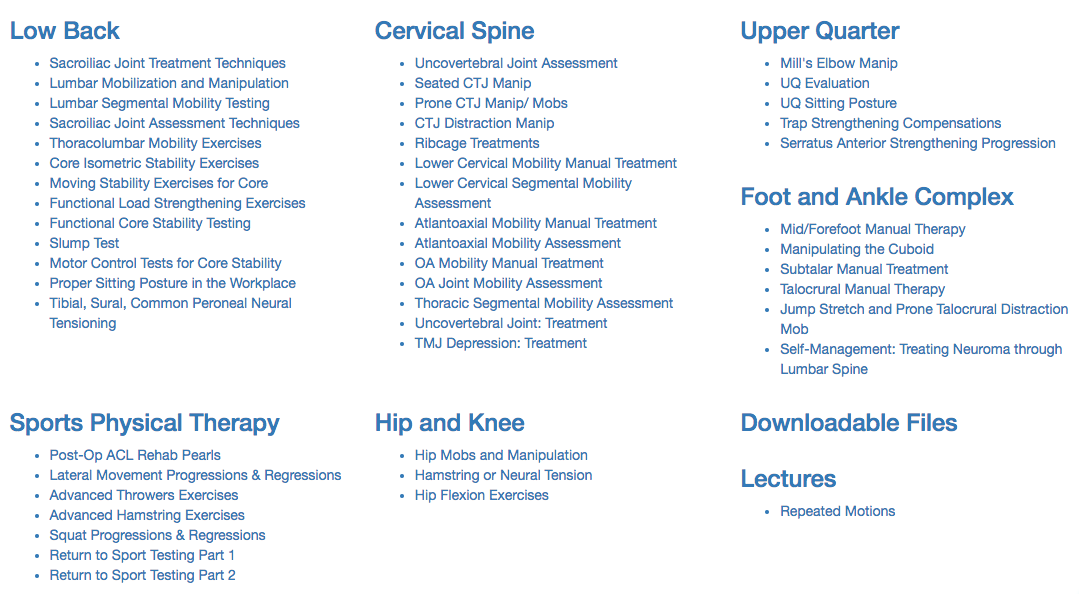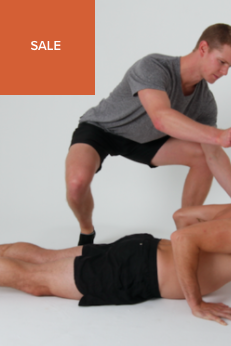- Home
- About Us
- TSPT Academy
- Online Courses
-
Resources
- Newsletter
- Business Minded Sports Physio Podcast
- Day in the Life of a Sports PT
- Residency Corner
-
Special Tests
>
-
Cervical Spine
>
- Alar Ligament Test
- Bakody's Sign
- Cervical Distraction Test
- Cervical Rotation Lateral Flexion Test
- Craniocervical Flexion Test (CCFT)
- Deep Neck Flexor Endurance Test
- Posterior-Anterior Segmental Mobility
- Segmental Mobility
- Sharp-Purser Test
- Spurling's Maneuver
- Transverse Ligament Test
- ULNT - Median
- ULNT - Radial
- ULNT - Ulnar
- Vertebral Artery Test
- Thoracic Spine >
-
Lumbar Spine/Sacroiliac Joint
>
- Active Sit-Up Test
- Alternate Gillet Test
- Crossed Straight Leg Raise Test
- Extensor Endurance Test
- FABER Test
- Fortin's Sign
- Gaenslen Test
- Gillet Test
- Gower's Sign
- Lumbar Quadrant Test
- POSH Test
- Posteroanterior Mobility
- Prone Knee Bend Test
- Prone Instability Test
- Resisted Abduction Test
- Sacral Clearing Test
- Seated Forward Flexion Test
- SIJ Compression/Distraction Test
- Slump Test
- Sphinx Test
- Spine Rotators & Multifidus Test
- Squish Test
- Standing Forward Flexion Test
- Straight Leg Raise Test
- Supine to Long Sit Test
-
Shoulder
>
- Active Compression Test
- Anterior Apprehension
- Biceps Load Test II
- Drop Arm Sign
- External Rotation Lag Sign
- Hawkins-Kennedy Impingement Sign
- Horizontal Adduction Test
- Internal Rotation Lag Sign
- Jobe Test
- Ludington's Test
- Neer Test
- Painful Arc Sign
- Pronated Load Test
- Resisted Supination External Rotation Test
- Speed's Test
- Posterior Apprehension
- Sulcus Sign
- Thoracic Outlet Tests >
- Yergason's Test
- Elbow >
- Wrist/Hand >
- Hip >
- Knee >
- Foot/Ankle >
-
Cervical Spine
>
- I want Financial Freedom
- I want Professional Growth
- I want Clinical Mastery
|
As physical therapists, we see many patients with a referring diagnosis of partial rotator cuff tear. Almost every patient with this pathoanatomic diagnosis will ask you one of these questions: "Can I injure it the tear worse? Will the muscle tear fully or recover? Will I need surgery?" These questions have complex answers with a myriad number of factors determining each answer. Below is a paragraph taken from the Orthopedic Physical Therapy Secrets book that should help answer the question, "Do partial rotator cuff tears heal or progress?" "1)Ruptured fibers can no longer sustain a load; thus increased loads are placed on neighboring fibers, making them more susceptible to rupture. 2) Disruption of the tendon fibers also disrupts local blood supply within the tendon, thus inducing ischemia. 3) Disrupted tendon fibers are exposed to joint fluid, which has a lytic effect on tendons that impairs the healing process. 4) When tendons heal, the scar tissue that replaces the ruptured tendon fibers does not have the same tensile strength as the original tissue; thus it is a increased risk of failure. 5) Once a tear becomes full thickness, loads that normally are distributed through the entire intact tendon often are transmitted at the torn margins of the rotator cuff tendon. This process produces a "zipper effect" and extends or unzips the tendon from the tuberosity. " From the information above, it is evident that in many instances, partial thickness rotator cuff tears progress to full thickness tears. The physiologic tissue structure following an injury has changed. The blood flow and tensile strength of that tissue has been permanently altered. It does appear that partial tears do progress. So where does this leave us? Fortunately, the physical therapy paradigm is shifting from a pathoanatomic to a pathokinesiologic model. Despite having a partial rotator cuff tear, patients can respond positively with conservative management. By addressing capsular mobility deficits, scapulohumeral strength and flexibility problems, and the presenting movement dysfunction, surgery is not always indicated following a rotator cuff tear. The Secrets book also states that variable amounts (33-90%) of individuals demonstrate improvements in pain and overall function despite having a full thickness rotator cuff tear. Not all patients will succeed with conservative management, but address your primary impairments and movement dysfunction and you will be able to decrease the patient's pain and improve their function. -Jim Heafner PT, DPT, OCS References: Placzek, Jeffrey D., and David A. Boyce. Orthopaedic Physical Therapy Secrets. St. Louis, MO: Mosby Elsevier, 2006. Print.
8 Comments
Mike
2/1/2015 02:15:14 am
What exercises and manual would you stay away from that you think Would make the tear worse? What exercises and manual would you incorporate into the program? Thanks
Reply
JeromeFrenchPT
2/1/2015 04:21:12 pm
Agree we could have great outcomes with conservative treatment. But, as you said the tears will progress and surgery will have better outcomes if it's done with a smaller tear, so...i think it's depend on patient's age, physical activities, job etc...
Reply
Jim Heafner
2/1/2015 07:27:01 pm
Jerome- you are exactly right. It is such a Catch-22: do surgery now with a smaller tear OR try conservative management and hope the tear doesn't progress...tough situation.
Reply
I think when it is small tear so many people do not want the long recovery associated with surgery. With some they do not heal 100%. Using techniques to heal the injured area first is a good route but be aware that further injury can happen. Especially as the shoulder has such a wide range of motion. I really believe in optimizing circulation to the affected area to bring in as much nutrient rich blood flow to help heal the injured tissues. Use of the BFST wrap is ideal as it does not put further strain on the tissues. Acupuncture, cold and heat wraps and ultrasound all have their pros and cons as well.
Reply
I think when it is small tear so many people do not want the long recovery associated with surgery. With some they do not heal 100%. Using techniques to heal the injured area first is a good route but be aware that further injury can happen. Especially as the shoulder has such a wide range of motion. I really believe in optimizing circulation to the affected area to bring in as much nutrient rich blood flow to help heal the injured tissues. Use of the BFST wrap is ideal as it does not put further strain on the tissues. Acupuncture, cold and heat wraps and ultrasound all have their pros and cons as well.
Reply
I think when it is small tear so many people do not want the long recovery associated with surgery. With some they do not heal 100%. Using techniques to heal the injured area first is a good route but be aware that further injury can happen. Especially as the shoulder has such a wide range of motion. I really believe in optimizing circulation to the affected area to bring in as much nutrient rich blood flow to help heal the injured tissues. Use of the BFST wrap is ideal as it does not put further strain on the tissues. Acupuncture, cold and heat wraps and ultrasound all have their pros and cons as well.
Reply
I think when it is small tear so many people do not want the long recovery associated with surgery. With some they do not heal 100%. Using techniques to heal the injured area first is a good route but be aware that further injury can happen. Especially as the shoulder has such a wide range of motion. I really believe in optimizing circulation to the affected area to bring in as much nutrient rich blood flow to help heal the injured tissues. Use of the BFST wrap is ideal as it does not put further strain on the tissues. Acupuncture, cold and heat wraps and ultrasound all have their pros and cons as well.
Reply
12/21/2022 03:52:25 am
I'm glad that you talked that tear in the rotator cuff is the common problem therapists experienced. My athlete brother suffered an rotator cuff injury because of their basketball game. He asked last night if I had any idea what would be the best treatment to consider. You did a great job of explaining the important factors of physical therapy, I'll tell him that consulting a trusted sports physical therapy service can help provide more information about the treatment.
Reply
Leave a Reply. |
Dr. Brian Schwabe's NEW Book in partner with PaleoHacks!
Learn residency-level content on our
Insider Access pages We value quality PT education & CEU's. Click the MedBridge logo below for TSPT savings!Archives
July 2019
Categories
All
|








 RSS Feed
RSS Feed